heating Oldsmobile Cutlass Supreme 1996 Owner's Manuals
[x] Cancel search | Manufacturer: OLDSMOBILE, Model Year: 1996, Model line: Cutlass Supreme, Model: Oldsmobile Cutlass Supreme 1996Pages: 356, PDF Size: 18.48 MB
Page 66 of 356
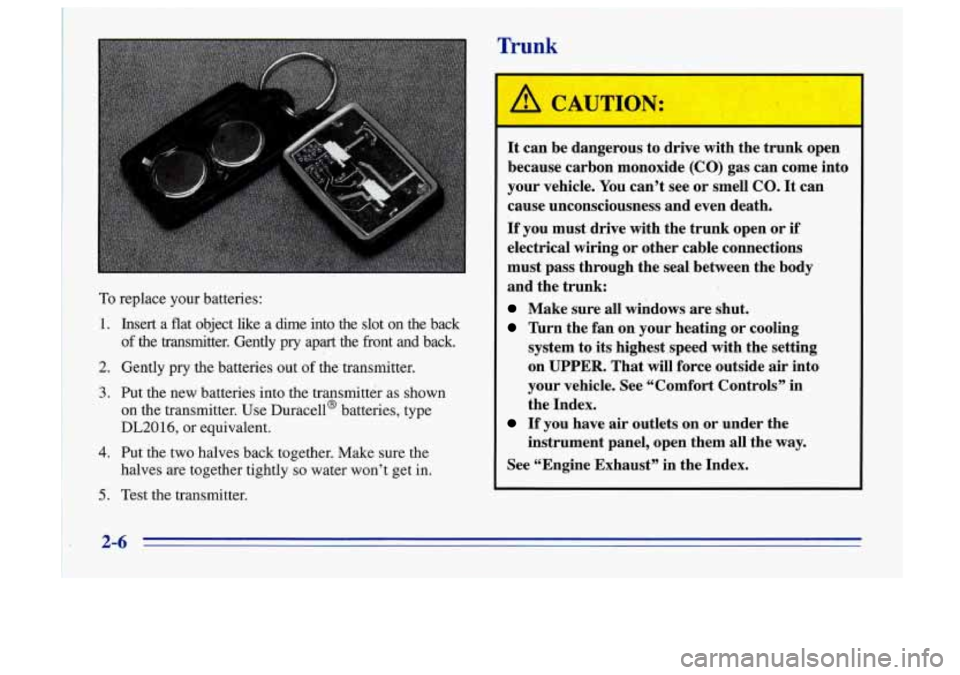
To replace your batteries:
1. . Insert a flat object like a dime into the slot on the back
of the transmitter. Gently pry apart the front and back.
2. Gently pry the batteries out of the transmitter.
3. Put the new batteries into the transmitter as shown
on the transmitter.
Use Duracell@ batteries, type
DL20 16, or equivalent.
4. Put the two halves back together. Make sure the
halves are together tightly
so water won’t get in.
5. Test the transmitter.
Trunk
It can be dangerous to drive with the trunk open
because carbon monoxide (CO) gas
can come into
your vehicle. You can’t see or smell CO.
It can
cause unconsciousness and even death.
If you must drive with the trunk open or if
electrical wiring or other cable connections
must pass through the seal between the body
and the trunk:
Make sure all windows are shut.
Turn the fan on your heating or cooling
system to its highest speed with the setting
on
UPPER. That will force outside air into
your vehicle. See “Comfort Controls” in
the Index.
instrument panel, open them all the way.
If you have air outlets on,or under the
See “Engine Exhaust” in the Index.
Page 99 of 356
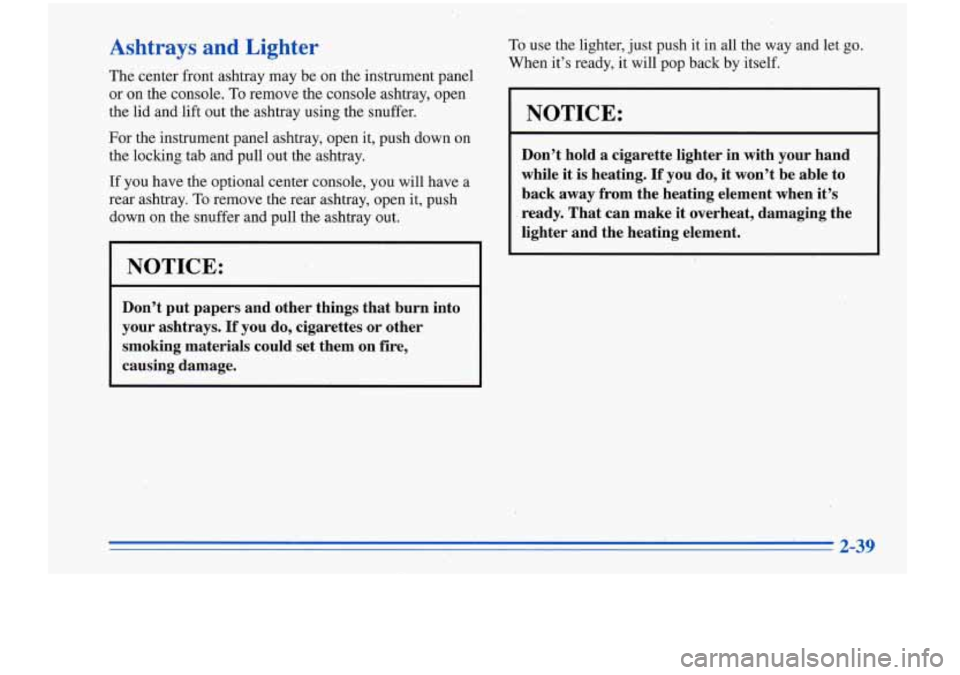
Ashtrays and Lighter
The center front ashtray may be on the instrument panel
or on the console.
To remove the console ashtray, open
the lid and lift out the ashtray using the snuffer.
For
the instrument panel ashtray, open it, push down on
the locking tab and pull out the ashtray.
If you have the optional center console, you will have a
rear ashtray.
To remove the rear ashtray, open it, push
down on
the snuffer and pull the ashtray out.
I I
I NOTICE:
Don’t put papers and’other things that burn into
your ashtrays.
If you do, cigarettes or other
smoking materials could set them on fire,
causing damage.
To use the lighter, just push it in all the way and let go.
When it’s ready,
it will pop back by itself.
I NOTICE:
Don’t hold a cigarette lighter in with your hand
while
it is heating. If you do, it won’t be able to
back away from the heating element when it’s
ready. That can make.it overheat, damaging the
lighter and the heating element.
2-39
Page 109 of 356

Anti-Lock Brake System Active Light
LOW
TRAC
When your anti-lock system
is adjusting brake pressure
to help avoid a braking skid,
the anti-lock brake system
active light will come
on.
Engine Coolant Temperature Light
HOT
This light tells you that
your engine coolant has
overheated or your radiator
cooling fan is not working.
Slippery road conditions may exist if this light comes
on,
so adjust your driving accordingly. The light will
stay on for a few seconds after the system stops
adjusting brake pressure.
The anti-lock brake system active light also comes on
briefly when you turn the ignition key to RUN. If the
light doesn’t come on then, have
it fixed so it will be
there to
tell you when the system is active. If you
have been operating your vehicle under normal
driving conditions, you should pull
off the road, stop
your vehicle and turn
off the engine as soon as possible.
In “Problems on the Road,” this manual shows what to
do. See “Engine Overheating” in the Index.
2-49
Page 110 of 356
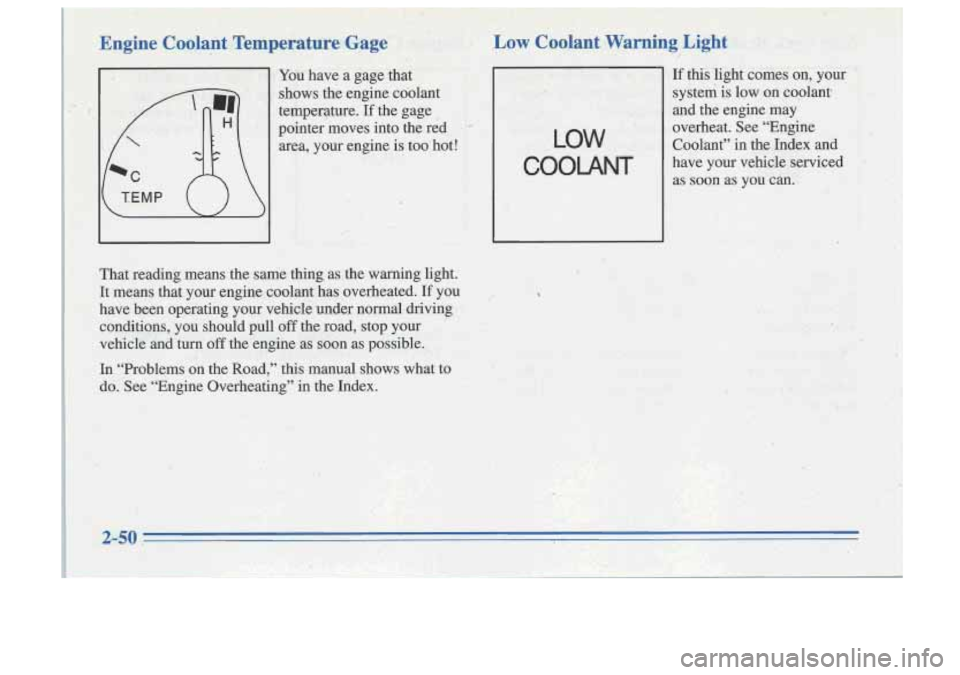
'- .
You have a gage that
(shows the engine coolant
temperqture. If 'the gage
pointer'moves into the red
. - .
area, your engine is too hot!
.. , _.
That reading means the sanie thing as the warning iight.
It nieans that your engine coolant. has Overheated. If you
have been operating your vehicle
under normal driving
conditions,
you should pull off the road, stop your
vehicle kd
turn off the engine as soon as possible.
In "Problems on the Road," this manual sh0w.s what to
do.-See "Engine Overheating" in the Index.
, ',
Page 119 of 356
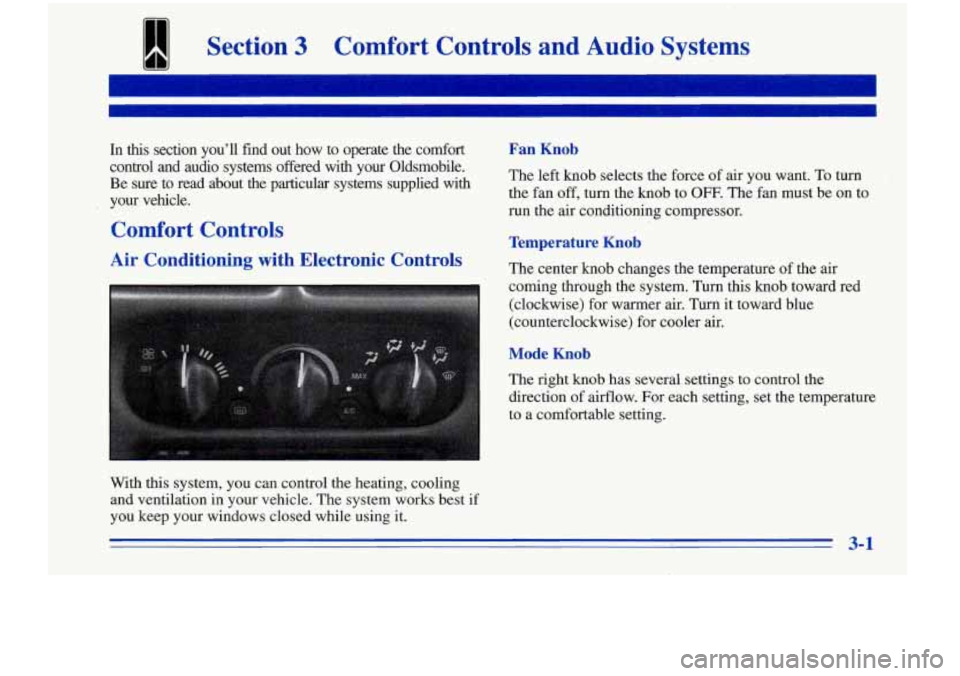
Section 3 Comfort Controls and Audio Systems
F- -- -I
In this section you’ll find out how to operate the comfort
control and audio systems offered with your Oldsmobile.
Be sure to read about
the particular systems supplied with
your vehicle.
Comfort Controls
Air Conditioning with Electronic Controls
With this system, you can control the heating, cooling
and ventilation in your vehicle. The system works best
if
you keep your windows closed while using it.
Fan Knob
The left knob selects the force of air you want. To turn
the fan off, turn the knob to OFF. The fan must be on to
run the air conditioning compressor.
Temperature Knob
The center knob changes the temperature of the air
coming through the system. Turn this knob toward red (clockwise) for warmer air. Turn it toward blue
(counterclockwise) for cooler air.
Mode Knob
The right knob has several settings to control the
direction of airflow. For each setting, set the temperature
to a comfortable setting.
3-1
Page 121 of 356
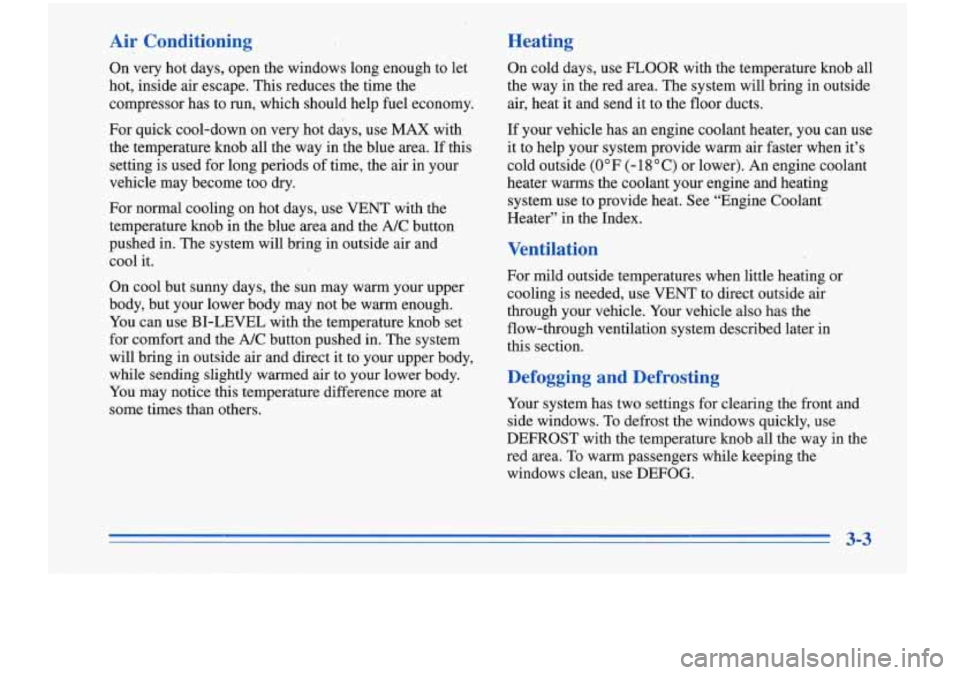
Air Conditioning
On very hot days, open the windows long enough to’let
hot, inside air escape. This reduces the time the
compressor has to run, which should help fuel economy.
For quick cool-down on very hot days, use
MAX with
the temperature knob all
the way in the blue area. If this
setting is used for long periods of time, the air in your
vehicle may become too
dry.
For normal cooling on hot days, use VENT with the
temperature knob in the blue area and the A/C button
pushed in. The system will bring in outside air and
cool it.
On cool but sunny days, the sun may warm your upper
body, but your lower body may not be warm enough.
You can use BI-LEVEL with the temperature knob set
for comfort and the A/C button pushed in. The system
will bring in outside air and direct it to your upper body,
while sending slightly warmed air
to your lower body.
You may notice this temperature difference more at
some times than others.
Heating
On cold days, use FLOOR with the temperature knob all
the way in the red area. The system will bring in outside
air, heat it and send it to the floor ducts.
If your vehicle has an engine coolant heater, you can use
it to help your system provide warm air faster when it’s
cold outside (0°F (-18°C) or lower). An engine coolant
heater warms the coolant your engine and heating
system use to provide heat. See “Engine Coolant
Heater” in the Index.
Ventilation
For mild outside temperatures when little heating or
cooling is needed, use VENT to direct outside air
through your vehicle. Your vehicle also has the
flow-through ventilation system described later in
this section.
Defogging and Defrosting
Your system has two settings for clearing the front and
side windows. To defrost the windows quickly, use
DEFROST with the temperature knob all the way in the
red area. To warm passengers while keeping the
windows clean, use DEFOG.
3-3
Page 124 of 356
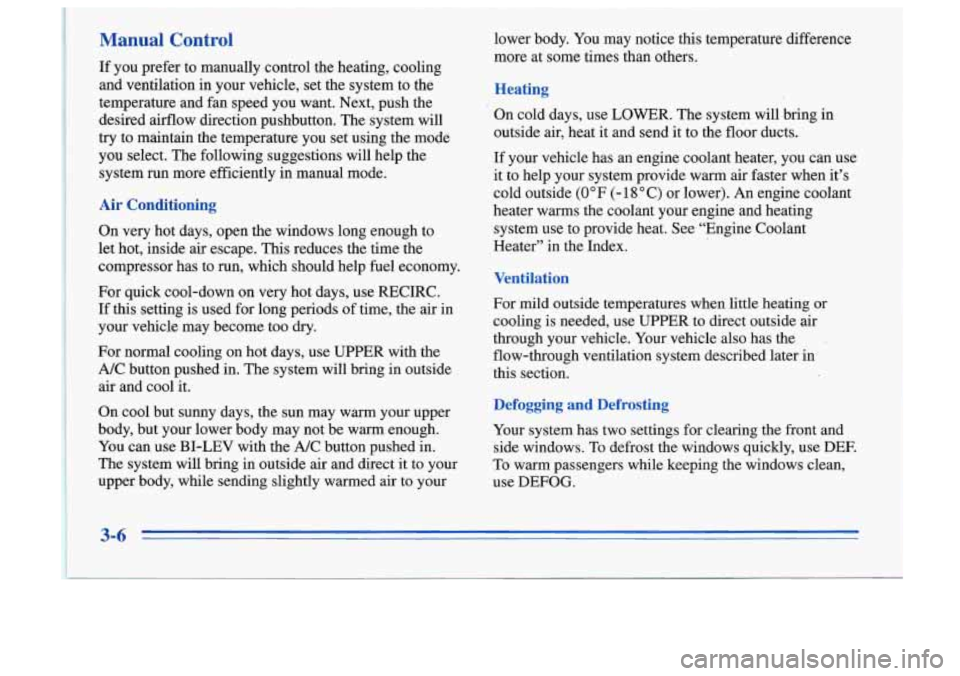
Manual Control
If you prefer to manually control the heating, cooling and ventilation in your vehicle, set the system to the
temperature and fan speed you want. Next, push the
desired airflow direction pushbutton. The system will
try to maintain the temperature you set using the mode
you select. The following suggestions will help the
system run more efficiently in manual mode.
Air Conditioning
On very hot days, open the windows long enough to
let hot, inside air escape. This reduces the time the
compressor has to run, which should help fuel economy.
For quick cool-down on very hot. days, use RECIRC.
If this setting is used for long periods of time, the air
in
your vehicle may become too dry.
For normal cooling on hot days, use UPPER with the
A/C button pushed in. The system will bring in outside
air and cool
it.
Heating
On cold days, use LOWER. The system will bring in
outside air, heat it and send it to the floor ducts.
If your vehicle has an engine coolant heater, you can use
it to help your system provide warm air faster when it’s
cold outside
(0°F (-18°C) or lower). An engine coolant
heater warms the coolant your engine and heating
system use to provide heat. See “Engine Coolant
Heater” in the Index.
Ventilation
For mild outside temperatures when little heating or
cooling is needed, use UPPER to direct outside air
through your vehicle. Your vehicle also has the
.
flow-through ventilation system, described later in
this section.
Defogging and Defrosting
Your system has two settings for clearing the front and
side windows.
To defrost the windows quickly, use DEF.
To warm passengers while keeping the windows clean,
use DEFOG.
On
cool but sunny days, the sun may warm your upper
body, but your lower body may not be warm enough.
You can use
BI-LEV with the A/C button pushed in.
I The system will bring in outside air and direct it to your
upper body, while sending slightly warmed air
to your
3-6
Page 182 of 356
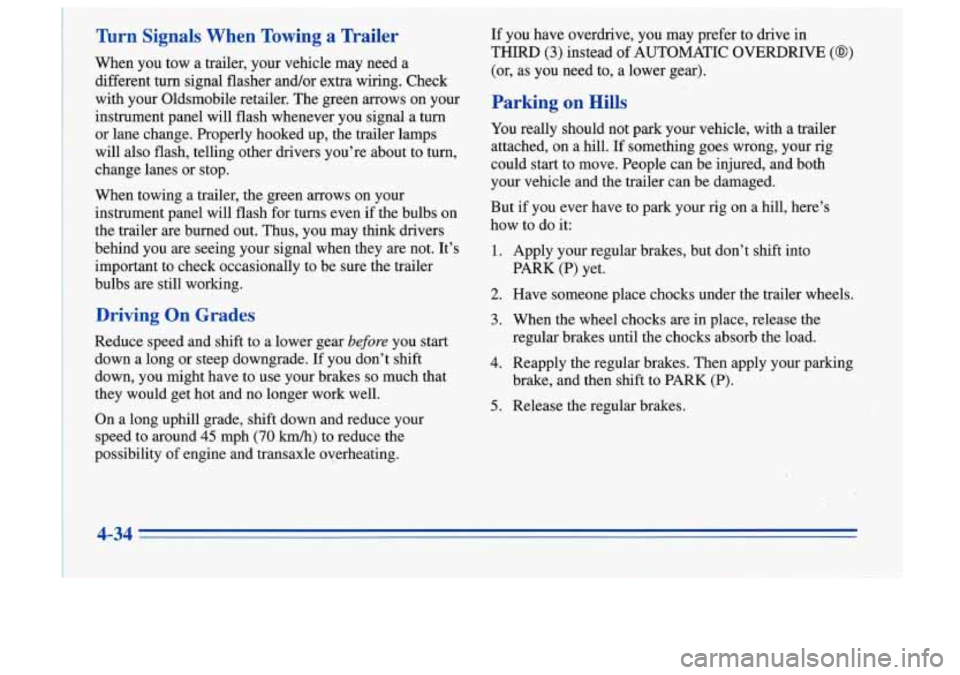
Thrn Signals When Towing a Trailer
When you tow a trailer, your vehicle may need a different turn signal flasher and/or extra wiring. Check
with your Oldsmobile retailer. The green arrows on your
instrument panel will flash !whenever you signal a
turn
or lane change. Properly hooked up, the trailer lamps
will also flash, telling other drivers you’re about to turn,
change lanes or stop.
When towing a trailer, the green arrows on your
instrument panel will flash for turns even if the bulbs on
the trailer are burned out. Thus, you may think drivers
behind you
are seeing your signal when they are not. It’s
important to check occasionally to be sure the trailer
bulbs
are still working.
Driving On Grades
Reduce speed and shift to a lower gear before you ,start
down
a long or steep downgrade. If you don’t shift
down, you might have to use your brakes
so much that
they would get hot and no longer work well.
On a long uphill grade, shift down and reduce your
speed to. around
45 mph (70 krn/h) to reduce the
possibility
of engine and transaxle overheating. If you
have overdrive, you may prefer to drive in
THIRD
(3) instead of AUTOMATIC OVERDRIVE (a)
(or, as you need to, a lower gear).
Parking on Hills
You really should not park your vehicle, with a trailer
attached, on a hill. If something goes wrong, your rig
could start to move. People can be injured, and both
your vehicle and the trailer can be damaged.
But
if you ever have to park your rig on a hill, here’s
how to do it:
1. Apply your regular brakes, but don’t shift into
2. Have someone place chocks under the trailer wheels.
3. When the wheel chocks are in place, release-the
regular brakes until the chocks absorb the load.
4. Reapply the regular brakes. Then apply your parking
brake, and then shift to PARK
(P).
5. Release the regular brakes. PARK
(P) yet.
4-34
Page 197 of 356
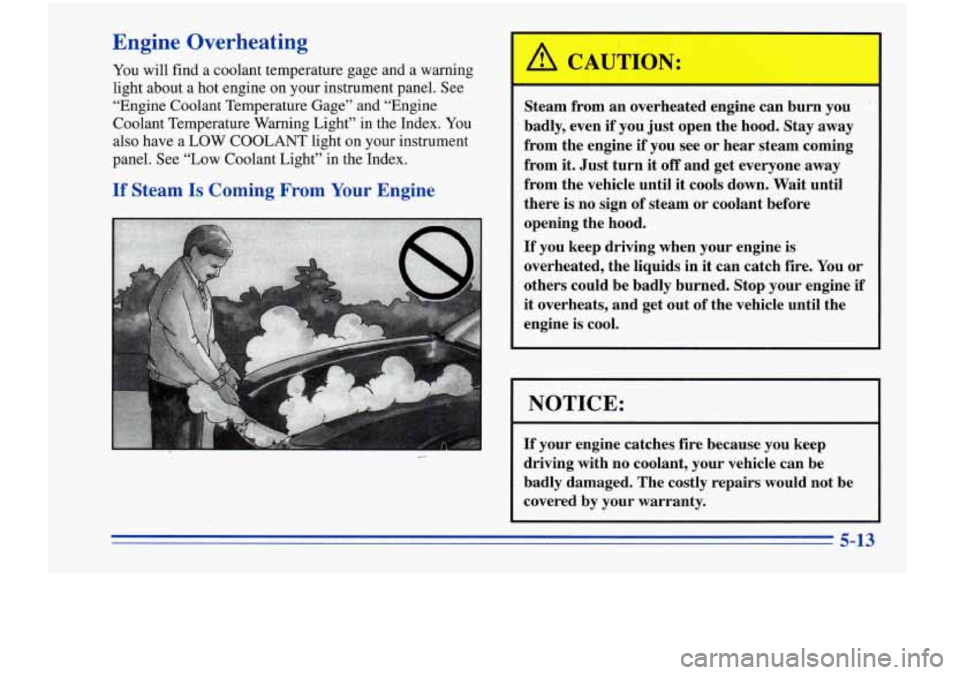
Engine Overheating
You will find a coolant temperature gage and a warning
light about a hot engine on your instrument panel.
See
“Engine Coolant Temperature Gage” and “Engine
Coolant Temperature Warning Light” in the Index. You
also have a LOW COOLANT light on your instrument
panel.
See “Low Coolant Light” in the Index.
If Steam Is Coming From Your Engine
Steam from an overheated engine can burn you ’
badly, even if you just open the hood. Stay away
from the engine if you see or hear steam coming
from
it. Just turn it off and get everyone away
from the vehicle until it cools down. Wait until
there is no sign of steam or coolant before
opening the hood.
If you keep driving when your engine is
overheated, the liquids in
it can catch fire. You or
others could be badly burned. Stop your engine if
it overheats, and get out of the vehicle until the
engine is cool.
~
I NOTICE:
If your engine catches fire because you keep
driving with no coolant, your vehicle can be
badly damaged. The costly repairs would not be
covered by your warranty.
5-13
Page 200 of 356

j If the coolant inside the coolant recovery tank is boiling,
don’t do anything
else until it cools down.
.. - ”r -+
Heater and radiator hoses, and otherengine
parts, can be very hot. Don’t touch them.
If you
do, you can be burned.
Don’t run the engine
if there is a leak. If you run
the engine,
it could lose all coolant. That could
cause an engine fiie,
and you could be burned.
Get any leak fixed before you drive the vehicle.
’
I NOTICE:
The coolant level should be at or above the COLD mark
on a cold engine. The coolant level should be at or
above the HOT mark on a hot engine. If it isn’t, you
may have a leak in the radiator hoses, heater hoses,
radiator, water pump or somewhere else in the cooling system.
r
Engine damage from running your engine
without coolant isn’t covered by your warranty.
If there seems to be no leak, with the engine on, check to
see if the electric engine fan(s) are running. If the engine
is overheating, both fan@) should be running; If they
aren’t, your vehicle needs service.
5-16